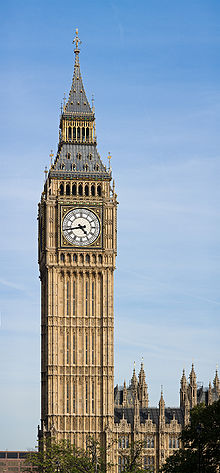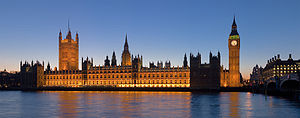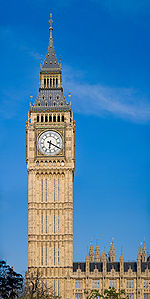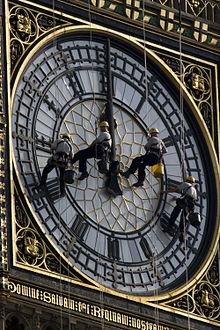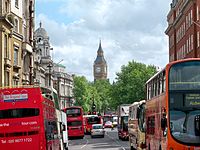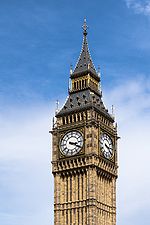- Big Ben
-
For other uses, see Big Ben (disambiguation).
Big Ben is the nickname for the great bell of the clock at the north end of the Palace of Westminster in London,[1] and is generally extended to refer to the clock or the clock tower as well.[2] It is the largest four-faced chiming clock and the third-tallest free-standing clock tower in the world.[3] It celebrated its 150th anniversary on 31 May 2009,[4] during which celebratory events took place.[5][6] The erecting of the tower was completed on 10 April 1858. The clock tower has become one of the most prominent symbols of both London and England, often in the establishing shot of films set in the city.
Contents
Tower
The present Clock Tower was raised as a part of Charles Barry's design for a new palace, after the old Palace of Westminster was largely destroyed by fire on the night of 16 October 1834.[7][8] The new Parliament was built in a Neo-gothic style. Although Barry was the chief architect of the Palace, he turned to Augustus Pugin for the design of the Clock Tower, which resembles earlier Pugin designs, including one for Scarisbrick Hall. The design for the Clock Tower was Pugin's last design before his final descent into madness and death, and Pugin himself wrote, at the time of Barry's last visit to him to collect the drawings: "I never worked so hard in my life for Mr Barry for tomorrow I render all the designs for finishing his bell tower & it is beautiful."[9] The tower is designed in Pugin's celebrated Gothic Revival style, and is 96.3 metres (316 ft) high (roughly 16 stories).[10]
The bottom 61 metres (200 ft) of the Clock Tower's structure consists of brickwork with sand coloured Anston limestone cladding. The remainder of the tower's height is a framed spire of cast iron. The tower is founded on a 15-metre (49 ft) square raft, made of 3-metre (9.8 ft) thick concrete, at a depth of 4 metres (13 ft) below ground level. The four clock dials are 55 metres (180 ft) above ground. The interior volume of the tower is 4,650 cubic metres (164,200 cubic feet).
Despite being one of the world's most famous tourist attractions, the interior of the tower is not open to overseas visitors, though United Kingdom residents are able to arrange tours (well in advance) through their Member of Parliament.[11] However, the tower has no lift, so those escorted must climb the 334 limestone stairs to the top.[10]
Because of changes in ground conditions since construction (notably tunnelling for the Jubilee Line extension), the tower leans slightly to the north-west, by roughly 220 millimetres (8.66 in) at the clock dials, giving an inclination of approximately 1/250.[12][13] Due to thermal effects it oscillates annually by a few millimetres east and west.
Clock
Dials
The clock dials are big enough that the Clock Tower was once the largest four-faced clock in the world.
The clock and dials were designed by Augustus Pugin. The clock dials are set in an iron frame 7 metres (23 ft) in diameter, supporting 312 pieces of opal glass, rather like a stained-glass window. Some of the glass pieces may be removed for inspection of the hands. The surround of the dials is gilded. At the base of each clock dial in gilt letters is the Latin inscription:
“ DOMINE SALVAM FAC REGINAM NOSTRAM VICTORIAM PRIMAM ” Which means O Lord, keep safe our Queen Victoria the First.
Movement
The clock's movement is famous for its reliability. The designers were the lawyer and amateur horologist Edmund Beckett Denison, and George Airy, the Astronomer Royal. Construction was entrusted to clockmaker Edward John Dent; after his death in 1853 his stepson Frederick Dent completed the work, in 1854.[14] As the Tower was not complete until 1859, Denison had time to experiment: Instead of using the deadbeat escapement and remontoire as originally designed, Denison invented the double three-legged gravity escapement. This escapement provides the best separation between pendulum and clock mechanism. The pendulum is installed within an enclosed windproof box sunk beneath the clockroom. It is 3.9m long, weighs 300 kg and beats every 2 seconds. The clockwork mechanism in a room below weighs 5 tons. On top of the pendulum is a small stack of old penny coins; these are to adjust the time of the clock. Adding a coin has the effect of minutely lifting the position of the pendulum's centre of mass, reducing the effective length of the pendulum rod and hence increasing the rate at which the pendulum swings. Adding or removing a penny will change the clock's speed by 0.4 seconds per day.[6]
On 10 May 1941, a German bombing raid damaged two of the clock's dials and sections of the tower's stepped roof and destroyed the House of Commons chamber. Architect Sir Giles Gilbert Scott designed a new five-floor block. Two floors are occupied by the current chamber which was used for the first time on 26 October 1950. Despite the heavy bombing the clock ran accurately and chimed throughout the Blitz.
The Big Ben clock tower has been tilting as a result of the excavation of tunnels near Westminster.[15] The tower has tilted an additional 0.9 mm each year since 2003,[16] and the tilt can now be seen by the naked eye.[17]
Malfunctions, breakdowns, and other outages
- 1916: for two years during World War I, the bells were silenced and the clock face darkened at night to prevent attack by German Zeppelins.[10]
- 1 Sept. 1939: although the bells continued to ring, the clock faces were darkened at night through World War II to prevent guiding Blitz pilots.[10]
- New Year's Eve 1962: The clock slowed due to heavy snow and ice on the long hands, causing the pendulum to detach from the clockwork, as it is designed to do in such circumstances, to avoid serious damage elsewhere in the mechanism—the pendulum continuing to swing freely. Thus it chimed in the new year 10 minutes late.[18]
- 5 August 1976: First and only major breakdown. The air brake speed regulator of the chiming mechanism broke after more than 100 years of torsional fatigue causing the fully wound 4 ton weight to spin the winding drum out of the movement, causing a large amount of damage. The Great Clock was shut down for a total of 26 days over nine months – it was reactivated on 9 May 1977; this was its longest break in operation since it was built. During this time BBC Radio 4 had to make do with the pips.[19] Although there were minor stoppages from 1977 to 2002 when the maintenance of the clock was carried out by the old firm of clockmakers Thwaites & Reed, these were often repaired within the permitted two hour downtime and not recorded as stoppages. Prior to 1970 the maintenance was carried out by the original firm of Dents and since 2002 by Parliamentary staff.
- 27 May 2005: the clock stopped at 10:07 pm local time, possibly due to hot weather; temperatures in London had reached an unseasonable 31.8 °C (90 °F). It restarted, but stopped again at 10:20 pm local time and remained still for about 90 minutes before restarting.[20]
- 29 October 2005: the mechanism was stopped for about 33 hours so the clock and its chimes could be worked on. It was the lengthiest maintenance shutdown in 22 years.[21]
- 7:00 am 5 June 2006: The clock tower's "Quarter Bells" were taken out of commission for four weeks[22] as a bearing holding one of the quarter bells was damaged from years of wear and needed to be removed for repairs. During this period, BBC Radio 4 broadcast recordings of British bird song followed by the pips in place of the usual chimes.[23]
- 11 August 2007: Start of 6-week stoppage for maintenance. Bearings in the clock's going train and the "great bell" striker were replaced, for the first time since installation.[24] During the maintenance works, the clock was not driven by the original mechanism, but by an electric motor.[25] Once again, BBC Radio 4 had to make do with the pips during this time.
Bells
Great Bell
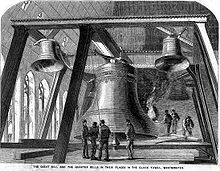 The second 'Big Ben' (centre) and the Quarter Bells from The Illustrated News of the World 4 December 1858
The second 'Big Ben' (centre) and the Quarter Bells from The Illustrated News of the World 4 December 1858
The main bell, officially known as the Great Bell, is the largest bell in the tower and part of the Great Clock of Westminster. The bell is better known by the nickname Big Ben.[26]
The original bell was a 16.3-tonne (16 ton) hour bell, cast on 6 August 1856 in Stockton-on-Tees by John Warner & Sons.[1] The bell was named in honour of Sir Benjamin Hall, and his name is inscribed on it.[27] However, another theory for the origin of the name is that the bell may have been named after a contemporary heavyweight boxer Benjamin Caunt.[28] It is thought that the bell was originally to be called Victoria or Royal Victoria in honour of Queen Victoria,[29] but that an MP suggested the nickname during a Parliamentary debate; the comment is not recorded in Hansard.
Since the tower was not yet finished, the bell was mounted in New Palace Yard. Cast in 1856, the first bell was transported to the tower on a trolley drawn by sixteen horses, with crowds cheering its progress. Unfortunately, it cracked beyond repair while being tested and a replacement had to be made. The bell was recast at the Whitechapel Bell Foundry as a 13.76-tonne (13½ ton) bell.[30][1] This was pulled 200 ft (61 m) up to the Clock Tower’s belfry, a feat that took 18 hours. It is 2.2 metres tall and 2.9 metres wide. This new bell first chimed in July 1859. In September it too cracked under the hammer, a mere two months after it officially went into service. According to the foundry's manager, George Mears, Denison had used a hammer more than twice the maximum weight specified.[1] For three years Big Ben was taken out of commission and the hours were struck on the lowest of the quarter bells until it was reinstalled. To make the repair, a square piece of metal was chipped out from the rim around the crack, and the bell given an eighth of a turn so the new hammer struck in a different place.[1] Big Ben has chimed with an odd twang ever since and is still in use today complete with the crack. At the time of its casting, Big Ben was the largest bell in the British Isles until "Great Paul", a 17 tonne (16¾ ton) bell currently hung in St Paul's Cathedral, was cast in 1881.[31]
Chimes
Click to hear BBC World Service announce itself, then play Westminster Chimes and the 12 strikes of Big Ben as broadcast at exactly 00:00:00 GMT on 1 January 2009.
Along with the Great Bell, the belfry houses four quarter bells which play the Westminster Quarters on the quarter hours. The four quarter bells are G♯, F♯, E, and B. They were cast by John Warner & Sons at their Crescent Foundry in 1857 (G♯, F♯ and B) and 1858 (E). The Foundry was in Jewin Crescent, in what is now known as The Barbican, in the City of London.
The Quarter Bells play a 20-chime sequence, 1–4 at quarter past, 5–12 at half past, 13–20 and 1–4 at quarter to, and 5–20 on the hour (which sounds 25 seconds before the main bell tolls the hour). Because the low bell (B) is struck twice in quick succession, there is not enough time to pull a hammer back, and it is supplied with two wrench hammers on opposite sides of the bell. The tune is that of the Cambridge Chimes, first used for the chimes of Great St Mary's church, Cambridge, and supposedly a variation, attributed to William Crotch, on a phrase from Handel's Messiah. The notional words of the chime, again derived from Great St Mary's and in turn an allusion to Psalm 37:23–24, are: "All through this hour/Lord be my guide/And by Thy power/No foot shall slide". They are written on a plaque on the wall of the clock room.[32][33]
Nickname
The origin of the nickname Big Ben is the subject of some debate. The nickname was applied first to the Great Bell; it may have been named after Sir Benjamin Hall, who oversaw the installation of the Great Bell, or after boxing's English Heavyweight Champion Benjamin Caunt.[1][26][34][35] Now Big Ben is often used, by extension, to refer to the clock, the tower and the bell collectively, although the nickname is not universally accepted as referring to the clock and tower.[2][36][37][38] Some authors of works about the tower, clock and bell sidestep the issue by using the words Big Ben first in the title, then going on to clarify that the subject of the book is the clock and tower as well as the bell.[39][40]
Significance in popular culture
The clock has become a symbol of the United Kingdom and London, particularly in the visual media. When a television or film-maker wishes to indicate a generic location in Britain, a popular way to do so is to show an image of the Clock Tower, often with a red double-decker bus or black cab in the foreground.[41] The sound of the clock chiming has also been used this way in audio media, but as the Westminster Quarters are heard from other clocks and other devices, the unique nature of this sound has been considerably diluted.
The Clock Tower is a focus of New Year celebrations in the United Kingdom, with radio and TV stations tuning to its chimes to welcome the start of the year. Similarly, on Remembrance Day, the chimes of Big Ben are broadcast to mark the 11th hour of the 11th day of the 11th month and the start of two minutes' silence.
ITN's News at Ten opening sequence features an image of the Clock Tower with the sound of Big Ben's chimes punctuating the announcement of the news headlines, and has done so on and off for the last 41 years. The Big Ben chimes (known within ITN as "The Bongs") continue to be used during the headlines and all ITV News bulletins use a graphic based on the Westminster clock dial. Big Ben can also be heard striking the hour before some news bulletins on BBC Radio 4 (6 pm and midnight, plus 10 pm on Sundays) and the BBC World Service, a practice that began on 31 December 1923. The sound of the chimes are sent in real time from a microphone permanently installed in the tower and connected by line to Broadcasting House.
Londoners who live an appropriate distance from the Clock Tower and Big Ben can, by means of listening to the chimes both live and on the radio or television, hear the bell strike thirteen times on New Year's Eve. This is possible due to what amounts to an offset between live and electronically transmitted chimes since the speed of sound is a lot slower than the speed of radio waves. Guests are invited to count the chimes aloud as the radio is gradually turned down.
The Clock Tower has appeared in many films, most notably in the 1978 version of The Thirty Nine Steps, in which the hero Richard Hannay attempted to halt the clock's progress (to prevent a linked bomb detonating) by hanging from the minute hand of its western dial. In the fourth James Bond film Thunderball a mistaken extra strike of Big Ben on the hour is designated by criminal organisation SPECTRE to be the signal that the British Government has acceded to its nuclear extortion demands. The gag phrase "Big Ben! Parliament!" is repeated for comic effect by Chevy Chase in National Lampoon's European Vacation as the depicted family remains stuck on the Lambeth Bridge Roundabout. It was also used in the filming of Shanghai Knights starring Jackie Chan and Owen Wilson, and was depicted as being partially destroyed in the Doctor Who episode "Aliens of London". An animated version of the clock and its inner workings were also used as the setting for the climactic final battle between Basil of Baker Street and his nemesis Ratigan in the Walt Disney animated film The Great Mouse Detective as well as Peter Pan where Peter lands on the clock before they head to Neverland. It is shown being destroyed by a UFO in the film Mars Attacks!, by a prehistoric creature in Gorgo, and by a lightning bolt in the film The Avengers. It is destroyed on purpose and quite graphically in the movie V for Vendetta and is flooded in the film Flood. In Reign of Fire, it is destroyed by dragons. The apparent "thirteen chimes" detailed above was also a major plot device in the Captain Scarlet and the Mysterons episode, "Big Ben Strikes Again".
During the 2010 General Election the results of the national exit poll were projected onto the face of Big Ben.[42]
Accolades
A survey of 2,000 people found that the tower was the most popular landmark in the United Kingdom.[43]
Big Ben was polled as the Most Iconic London Film Location.[44]
See also
References
- ^ a b c d e f "The Story of Big Ben". Whitechapel Bell Foundry. http://www.whitechapelbellfoundry.co.uk/bigben.htm. Retrieved 19 October 2008.
- ^ a b Fowler, H. W. (1976). The Concise Oxford dictionary of current English. First edited by H. W. Fowler and F. G. Fowler (Sixth edition ed.). Clarendon Press. p. 95. ISBN 0198611218. "Big Ben, great bell, clock, and tower, of Houses of Parliament"
- ^ [1][dead link]
- ^ "Happy birthday, Big Ben", The Times (UK) (69521): p. 1, 1 January 2009
- ^ Join in the anniversary celebrations, United Kingdom Parliament, http://www.bigben.parliament.uk/ixbin/indexplus?record=ART16
- ^ a b "Great Clock facts". Big Ben. London: UK Parliament. 13 November 2009. http://www.parliament.uk/about/livingheritage/building/big_ben/facts_figures/great_clock_facts.cfm. Retrieved 23 November 2009.
- ^ "Big Ben—Frequently asked questions". UK Parliament. http://www.parliament.uk/about/living-heritage/building/palace/big-ben/enquiries/. Retrieved 18 August 2011.
- ^ "Key dates: 1289-1834". UK Parliament. http://www.parliament.uk/about/living-heritage/building/palace/big-ben/key-dates-/1289-90/. Retrieved August 2011.
- ^ Rosemary Hill, God's Architect: Pugin & the Building of Romantic Britain (2007) p. 482
- ^ a b c d "Bong! Big Ben rings in its 150th anniversary". Associated Press. 29 May 2009. http://www.msnbc.msn.com/id/31002198/. Retrieved 1 June 2009.
- ^ "Clock Tower tour – UK Parliament". Parliament.uk. 21 April 2010. http://www.parliament.uk/visiting/visitingandtours/bigben.cfm. Retrieved 30 September 2010.
- ^ "A tale of two towers: Big Ben and Pisa" (PDF). http://www.royalsoced.org.uk/events/reports/2001-2002/rae_02.pdf. Retrieved 30 September 2010.
- ^ Staff (January 1997). "Tunnel Vision". Post Report Summary. Parliamentary Office of Science and Technology. http://www.parliament.uk/post/pn090.pdf.
- ^ "Denison, Dent and delays". Building the Great Clock. London: UK Parliament. 13 November 2009. http://www.parliament.uk/about/livingheritage/building/big_ben/building_clock_tower/building_great_clock.cfm. Retrieved 23 November 2009.
- ^ http://www.ingenia.org.uk/ingenia/issues/issue9/mair.pdf
- ^ TIME Magazine Vol. 178, No. 16| 2011
- ^ http://newsfeed.time.com/2011/10/10/report-big-ben-could-become-leaning-tower-of-london/
- ^ Namih, Carina (11 August 2007). "Big Ben silenced for maintenance". The Daily Telegraph (London). http://www.telegraph.co.uk/news/uknews/1559986/Big-Ben-silenced-for-maintenance.html. Retrieved 26 April 2010.
- ^ Peter MacDonald. Big Ben: The Bell, the Clock and the Tower. ISBN 0750938277.
- ^ "Big Ben chimes stoppage mystery". BBC News. 28 May 2005. http://news.bbc.co.uk/1/hi/england/london/4589527.stm. Retrieved 26 April 2010.
- ^ "In pictures: Big Ben's big turn off". BBC News. 29 October 2005. http://news.bbc.co.uk/1/hi/in_pictures/4389002.stm. Retrieved 26 April 2010.
- ^ Hutton, Robert (4 June 2006). "Big Ben's Chime Won't Sound the Same to Londoners for a While". Bloomberg. http://www.bloomberg.com/apps/news?pid=10000102&sid=ak.qvEQ42YM4&refer=uk. Retrieved 30 September 2010.
- ^ "The Editors: Bongs and Birds". BBC News. 2006. http://www.bbc.co.uk/blogs/theeditors/2006/06/bongs_and_birds.html.
- ^ "Big Ben silenced for repair work". BBC News. 11 August 2007. http://news.bbc.co.uk/1/hi/uk/6941611.stm. Retrieved 26 April 2010.
- ^ "Big Ben 1859 – 2009 – Keeping the Great Clock ticking". UK Parliament. http://www.bigben.parliament.uk/ixbin/indexplus?record=ART134. Retrieved 27 May 2009.
- ^ a b UK Parliament – The Great Bell (Big Ben). Retrieved 13 July 2007. Archived October 12, 2007 at the Wayback Machine
- ^ "Big Ben of Westminster". The Times (London) (22505): 5. 22 October 1859. "It is proposed to call our king of bells 'Big Ben' in honour of Sir Benjamin Hall, the President of the Board of Works, during whose tenure of office it was cast"
- ^ "The Great Bell – Big Ben". The building and its collections. London: UK Parliament. 13 November 2009. http://www.parliament.uk/about/livingheritage/building/big_ben/building_clock_tower/great_bell.cfm. Retrieved 23 November 2009.
- ^ "How did Bigger Ben get its Name? – Big Ben – Icons of England". Icons.org.uk. http://www.icons.org.uk/theicons/collection/big-ben/features/how-did-big-ben-get-its-name. Retrieved 30 September 2010.
- ^ The actual weight quoted by the founders is 13 tons 10 cwts 3 qtrs 15 lbs
- ^ "The History of Great Paul". Bell foundry museum, Leicester. Archived from the original on 6 April 2008. http://web.archive.org/web/20080406001107/http://www.inloughborough.com/local+history/Great_Paul.shtml. Retrieved 19 October 2008.
- ^ Milmo, Cahel (5 June 2006). "Bong! A change of tune at Westminster". The Independent (London). http://www.independent.co.uk/news/uk/this-britain/bong-a-change-of-tune-at-westminster-481163.html. Retrieved 8 April 2008.
- ^ Lockyer, Herbert (1993). A devotional commentary on psalms. Grand Rapids, MI: Kregel Christian Books. p. 149. ISBN 0825431468.
- ^ UK Parliament – The Clock Tower (Big Ben): Facts and figures Accessed 13 July 2007[dead link]
- ^ UK Parliament – Clock Tower close-up Accessed 13 July 2007[dead link]
- ^ Betts, Jonathan D. (26 November 2008). "Big Ben". Encyclopædia Britannica. Encyclopædia Britannica Online. http://www.britannica.com/EBchecked/topic/64921/Big-Ben. Retrieved 27 October 2008.
- ^ "Big Ben". The Columbia Encyclopedia. Columbia University Press. 2001–07. http://www.bartleby.com/65/bi/BigBen.html. Retrieved 27 October 2008.
- ^ "Big Ben". Encarta World English Dictionary [North American Edition]. Microsoft Corporation. 2009. Archived from the original on 31 October 2009. http://www.webcitation.org/5kwQ5lg9Y. Retrieved 14 January 2009.
- ^ "Big Ben and the Westminster Clock Tower". isbndb.com. http://isbndb.com/d/book/big_ben_and_the_westminster_clock_tower.html. Retrieved 27 October 2008.
- ^ "Big Ben: The Bell, The Clock And The Tower". isbndb.com. http://isbndb.com/d/book/big_ben_the_bell_the_clock_and_the_tower.html. Retrieved 27 October 2008.
- ^ Patterson, John (1 June 2007), "City Light", The Guardian (London), http://arts.guardian.co.uk/filmandmusic/story/0,,2091939,00.html
- ^ "General election results beamed onto Big Ben". parliament.uk. http://www.parliament.uk/business/news/2010/05/big-ben-projections/. Retrieved 30 September 2010.
- ^ "Big Ben 'UK's favourite landmark'". BBC News. 9 April 2008. http://news.bbc.co.uk/1/hi/england/london/7337319.stm. Retrieved 26 April 2010.
- ^ "Big Ben most iconic London film location". metro.co.uk. http://www.metro.co.uk/fame/article.html?in_article_id=72142&in_page_id=7.
External links
- Official website
- Palace of Westminster factsheetPDF (395 KB)
- Whitechapel Bell Foundry on Big Ben
- UK parliament's interior photos of Big Ben and the Clock Tower
- Innovative engineering to control Big Ben's tiltPDF (747 KB) – A technical paper from Cambridge University
- Big Ben's old clapper as forged in Houghton-le-Spring, Co Durham
Coordinates: 51°30′02.2″N 00°07′28.6″W / 51.500611°N 0.124611°W
Categories:- Buildings and structures completed in 1859
- Bell towers
- Bells
- Clock towers in the United Kingdom
- National government buildings in London
- Buildings and structures in London
- Visitor attractions in London
- Buildings and structures in Westminster
- Visitor attractions in Westminster
- Gothic Revival architecture in London
- Turret clocks
- Palace of Westminster
Wikimedia Foundation. 2010.

